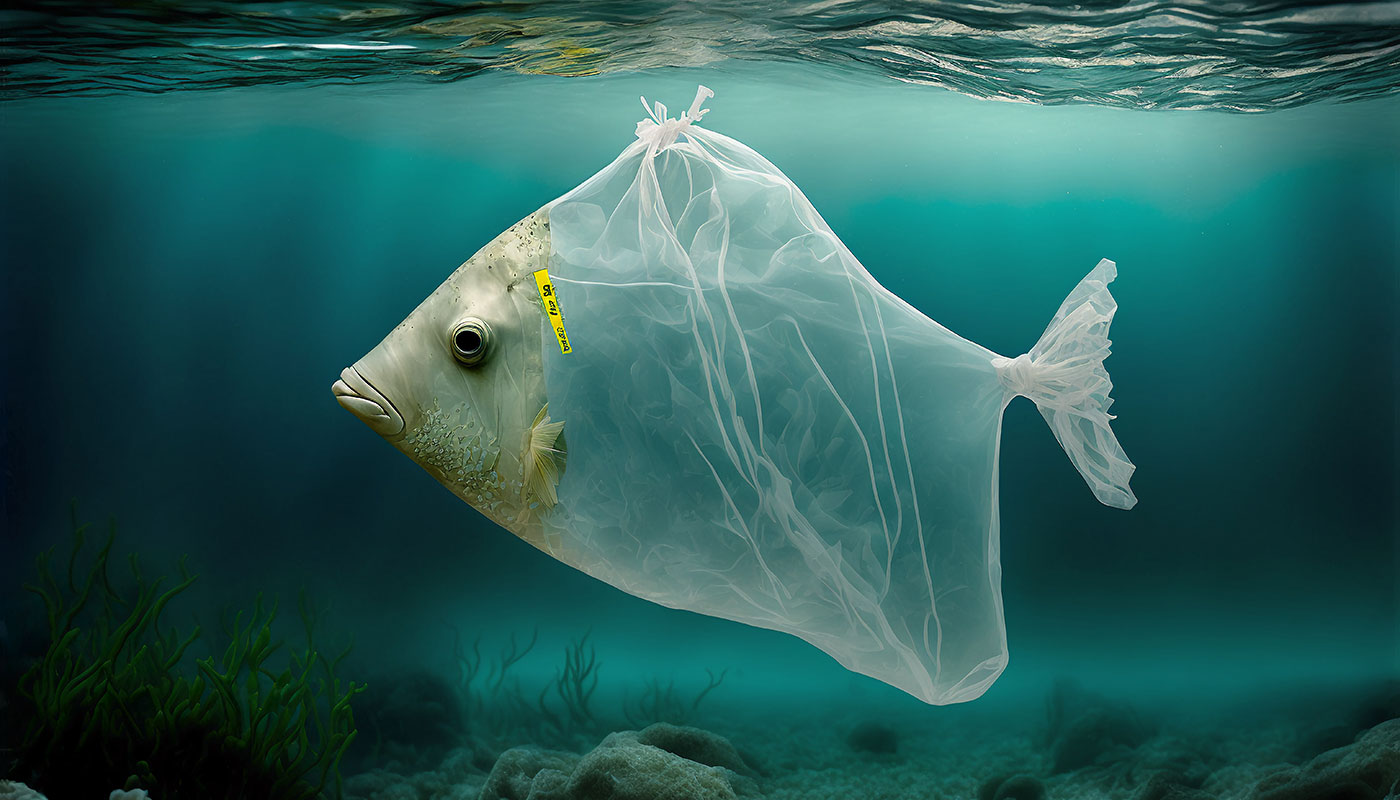
Cleaning the world's oceans – one patent at a time
Every year, millions of tons of plastic find their way into our rivers and oceans, threatening wildlife and contaminating water supplies. This problem only compounds with time since plastic does not decompose in the environment. Unless removed from the world's water, these pollutants will linger and continue causing harm for centuries to come. Thankfully, resourceful innovators around the globe are developing ways to do just that.
Remediating ocean and river pollution — as well as working to preserve the quality of waters that have not suffered the same spoilation — is key to long-term environmental and social health.
We look at some inventions that are positively contributing to the sustainability of our aquatic ecosystems and the Intellectual Property (IP) rights that safeguard their research and development.
On the road to sustainability
Microplastics are tiny pieces of material (less than 5mm in size) that result when larger plastic waste breaks up over time or when synthetic fibers such as nylon shed from fabrics. These particles are a major ocean pollutant, with a study by the World Wide Fund for Nature (WWF) estimating that humans might consume up to 200 milligrams of plastic a day in their drinking water.
Yet the second-largest source of microparticulate waste in the ocean comes from an often-overlooked source: car tires. Hugo Richardson, a co-founder of The Tyre Collective, learned this during his postgraduate research at the Royal College of Art and Imperial College London. With colleagues Hanson Cheng and Siobhan Anderson, Richardson started a project to tackle the tire-waste problem.
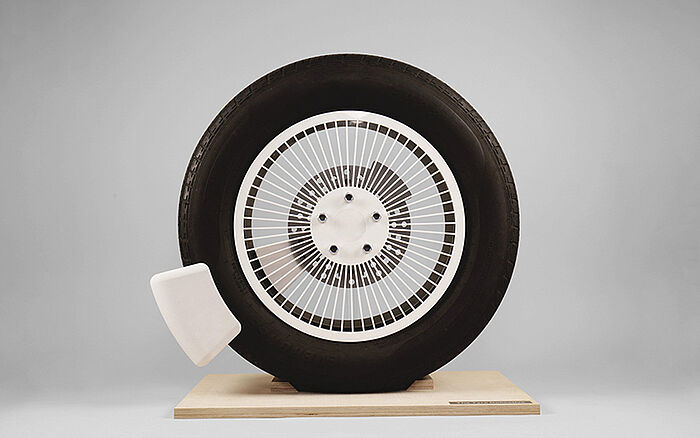
Only about 40% of the rubber in car tires comes from nature; the remaining 60% is synthetically produced from petroleum-sourced hydrocarbons. (Image credit: https://deepakmallya.com/the-tyre-collective)
The trio, together with Deepak Mallya, developed a prototype that attaches to a vehicle's underside to catch particles of synthetic rubber as a tire erodes. Their efforts earned them the James Dyson Award for student design in 2020. While the Collective is still refining its product, patents for the underlying solution are currently pending at the European Patent Office (EPO) and through the Patent Cooperation Treaty (PCT).
A deep dive into underwater analysis
It is important to know the exact level and type of pollution in a given body of water in order to clean it up most effectively. However, the oceans' vastness makes this kind of data collection by conventional means too draining on resources for most to consider. This is where artificial intelligence (AI) comes in.
Two companies from the United States have made some particularly intriguing developments in this area: ProMare and Terradepth. The former, a non-profit firm, developed a fully automated surface vessel called the Mayflower Autonomous Ship (MAS). On the other side of the waterline, startup Terradepth builds AI-guided submarines which are deployable from the shore, ships and even aerial platforms and can be equipped with sonar and photogrammetric and bathymetric sensors, among others.
ProMare's MAS, which crossed the Atlantic in June 2022, is focused on sustainability and can run sophisticated analytics on the ocean depths without a human crew. To this end, ProMare has the technological and financial backing of a host of sponsoring companies and research institutions from IBM to the University of Oxford. Members of the public were able to trace its route across the Atlantic Ocean from Plymouth, UK, to Plymouth, Massachusetts, chosen in honor of its historical namesake. A live feed from its array of onboard cameras and other sensors brought home the magnitude of the solo journey, not dissimilar to the real-time tracking of the Perseverance Mars rover.
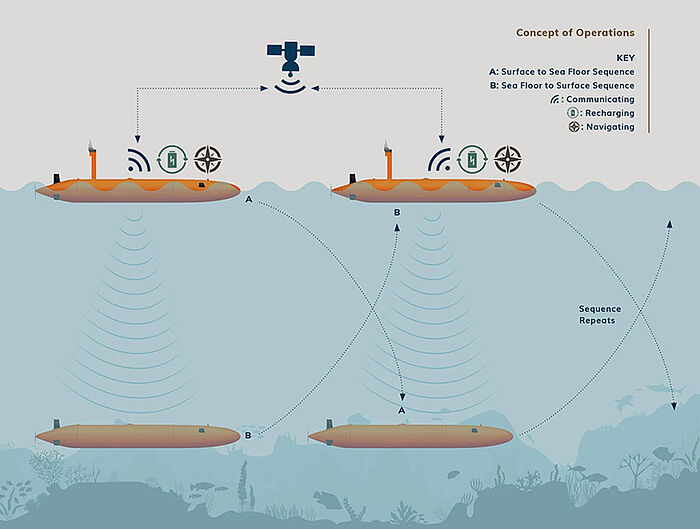
Autonomous vessels such as the Terradepth surveyors can persevere in their tasks for much longer than any diver or remote operator. Their tirelessly gathered data will be invaluable in subsequent waste prevention and cleanup efforts. (Image credit: Terradepth)
Terradepth, which cites environmental surveying as one of its numerous applications, has pending patents for its navigation and fuel cell charging systems, as well as for the submarines themselves. Powered by internal generators that combine stored hydrogen with atmospheric oxygen to release electricity, the only waste product is pure water – hardly an issue in the ocean. What is more, these vessels are able to transmit a wealth of data to researchers and engineers much more effectively than a team of divers and with better coverage than static sensors.
These fledgling projects demonstrate how AI and renewable energy can be combined to tackle the grave issues surrounding environmental damage in a way that is efficient in terms of money and manpower.
Tackling trash head-on
In the Netherlands, startup RanMarine's flagship product is fighting water pollution more directly. The WasteShark is an autonomous drone system that can be deployed in waterways to gather up to 500kg of debris a day. Using waypoint pathing, the device can also utilize anti-collision AI to maneuver within busy harbors and avoid wildlife.
The invention comprises two main components: the compact, electrically powered unit that uses a 4G communications band — or optional light detection and ranging (LiDAR) technology — to navigate and the storage bin that filters floating waste from the water. A larger version called the MegaShark, capable of being driven by its operator like a conventional boat, features both suction jets and an onboard compactor to increase the amount of pollution that can be collected. Whereas the WasteShark is designed with urban areas and marinas in mind, the MegaShark sinks its proverbial teeth into more expansive areas such as estuaries and ports.
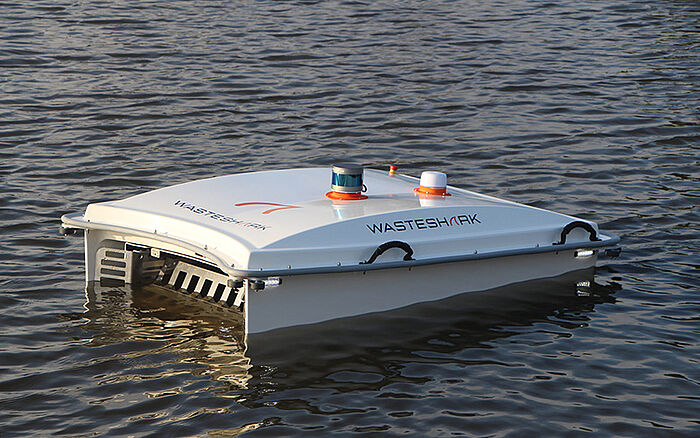
Modeled after the filter-feeding whale shark, the WasteShark swallows water pollutants before they can enter the marine food chain. (Image credit: RanMarine)
RanMarine has already registered multiple trademarks for the WasteShark name across several jurisdictions, indicating that the concept really holds water.
If the WasteShark is the equivalent of a pond skimmer, the Seabin is the equivalent of a trash can. Launched in 2015 by Andrew Turton and Pete Ceglinski of Australia, the simple but effective solution of placing a filtration bin and suction pump in city waterways can remove up to 90,000 plastic bags a year.
In the early days of the project, data collection consisted of pen, paper and spreadsheets. But the founders quickly recognized the need for digitalization to make the biggest impact. Today, the latest iterations of the Seabin house "smart technology, water sensors and a modem for cloud-based or IoT (internet of things) connectivity." In its home city of Sydney, Seabin has even established the world's first Microplastic and Ocean Health Research Lab to study and ultimately mitigate the problem of urban water pollution.
The great barrier relief
Like the WasteShark's creators, Boyan Slat is based in the Netherlands. However, as founder and CEO of The Ocean Cleanup, his undertaking operates on a much larger scale. Instead of locating and collecting waste using drone vehicles, Slat's interceptor system involves monitoring the ocean's currents and using computational modeling to predict where surface waste will accumulate. This trash can then be funneled by floating barriers that function as artificial coastlines to make waste collection easier and more efficient.
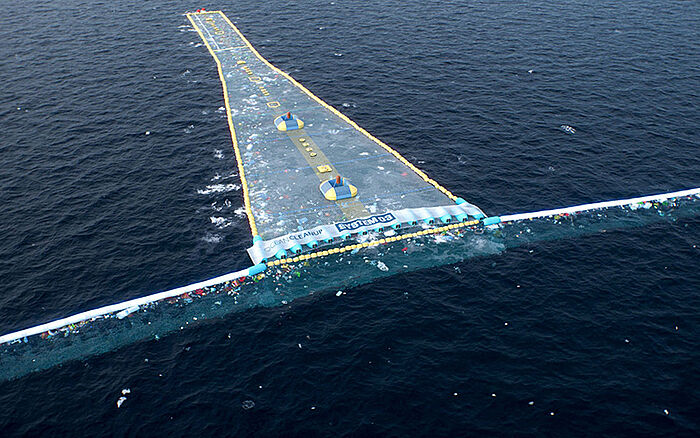
The Ocean Cleanup systems trap, funnel and retain floating waste for extraction. Importantly, aquatic life is able to swim safely under these barriers to avoid entrapment. (Image credit: The Ocean Cleanup)
Slat has made tackling the Great Pacific Garbage Patch one of his organization's biggest priorities. This area of floating debris between Hawai'i and California is estimated to cover around 1.6 million square kilometers – roughly twice the size of Texas or three times the size of France. Paired with preventative efforts and reduced reliance on single-use plastics, the project aims to remove 90% of floating ocean plastic by 2040.
One of these tandem projects comprises the river-borne autonomous waste collectors called Interceptors. These solar-powered sister devices of the oceanic system aim to stop waste from leaving shores in the first place. Already sporting a catchy trademark and a pending patent, the progress of the worldwide fleet of Interceptors can be followed online, currently standing at more than 2.1 million kg of collected waste.
An attractive solution to oil spills
Growing up on the Caribbean island of Barbados, Arden Warner witnessed the direct impact of ocean pollution on fragile ecosystems. While his ostensible "day job" is working with cutting-edge particle accelerators at the United States Department of Energy's Fermilab site in Batavia, Illinois, Warner is mentioned here for his efforts to perfect a unique method of resolving ocean oil spills.
Warner began working on oil cleanup methods in the early 2010s, following the Deepwater Horizon disaster. In 2014, he first received a patent for a boom system that created an electromagnetic field to manipulate the flow of magnetized oil for easier cleanup. His approach first "seeds" an oil spill with micron-sized magnetite particles that form a preferential but reversible bond with oil. Crucially, magnetite is naturally occurring, non-toxic and – of course – magnetic.
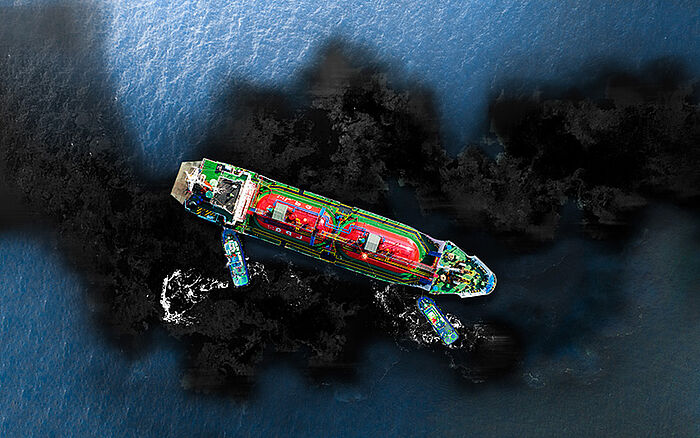
According to the International Tanker Owners Pollution Federation Limited (ITOPF), approximately 15,000 tonnes of oil were lost from tankers in 2022. Most of this was attributed to three large-scale accidents.
Once the seed particles have bonded with the oil, long booms of donut-shaped electromagnets pull the oil toward a collection ramp. Each electromagnet cycles on and off in sequence to draw in the oil progressively. Behind the ramp, a storage tank holds the mixture where a powerful magnet strips the magnetite away from the captured oil, allowing both to be reused. Warner's startup, Natural Science LLC, is currently in the process of commercializing its range of products that are subject to numerous granted and pending patents.
No single invention is able to solve the problem of water pollution globally. Even with the combined efforts of innovators from around the world, the environmental damage we see today will take decades to resolve. This makes long-term IP protections for the systems and devices carrying out this invaluable work all the more important.
Dennemeyer is committed to securing patents for those inventors and companies striving to preserve our oceans, rivers, beaches and lakes. To help ensure a brighter, healthier future for all, we must clean up our act today.
Filed in

Take a closer look at some of the top pharmaceutical trends and how IP is driving and being driven by these changes.



